This article dives into some amazing ABA techniques designed to help children with autism develop their gross motor skills! It highlights how important it is to create individualized treatment plans filled with engaging activities like:
These fun and structured approaches not only boost physical abilities but also build confidence, social skills, and emotional well-being.
Imagine your child joyfully navigating an obstacle course, laughing and learning along the way! These activities can truly make a difference. By focusing on what works best for each child, we can create a supportive environment where they thrive. So, let’s explore this together and see how these techniques can transform playtime into a wonderful learning experience! We’re here to help you every step of the way!
Engaging children with autism in physical activities can really boost their gross motor skills! Yet, many parents find themselves wondering where to begin. In this article, we’ll explore ten innovative ABA techniques that not only support physical development but also build confidence and social interaction among children.
With a focus on fun and dynamic activities—from animal walks to swimming—parents and caregivers will discover how these approaches can turn therapy into a joyful experience.
How can these playful methods reshape the developmental journey for children with autism? Let’s dive in together!
At Rori Care, we understand the unique challenges that parents face when it comes to supporting their children with autism. That's why we take a data-driven approach to ABA intervention, focusing on individualized treatment plans that cater to the specific gross motor actions ABA needs of each child. By conducting thorough evaluations, our clinicians can pinpoint each child's unique strengths and challenges, paving the way for targeted interventions that truly foster skill development.
We’re excited to share that Rori Care harnesses advanced AI technology to streamline progress report creation and data gathering during therapy sessions. This means more efficiency in therapy and, guess what? It frees up 50% more time for direct treatment! This personalized approach not only boosts physical skills but also nurtures confidence and self-reliance in our young ones.
And it doesn’t stop there! We equip caregivers with practical strategies, like using ABA principles at home and actively participating in data collection, to help support their children’s behavioral goals. Let’s explore this journey together! We’re here to help you every step of the way!
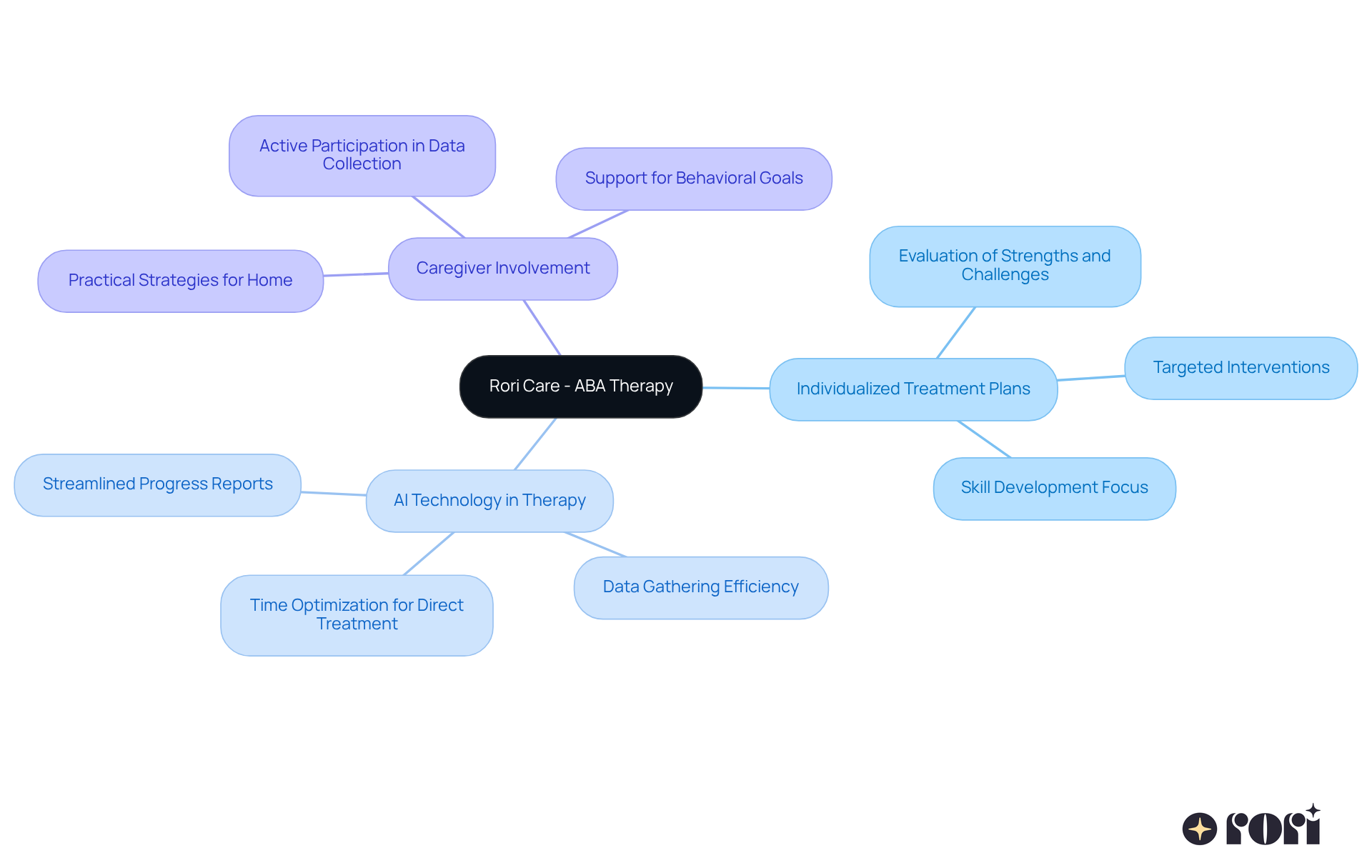
Animal movements, like bear crawls and frog hops, are not just fun; they’re dynamic exercises that can really help improve coordination and strength in children! These playful activities engage multiple muscle groups, making the experience enjoyable and beneficial for little ones. 🌟
Did you know that integrating animal movements into treatment sessions can enhance body awareness and coordination? These skills are essential for the development of gross motor actions aba. For instance, pursuits like animal walking encourage physical fitness while also boosting cognitive abilities through shape recognition tasks. It’s amazing how movement can strengthen the link between learning and play!
Experts highlight that these lively activities can lead to improved attention spans and overall physical coordination. This makes the use of gross motor actions aba a fantastic approach in ABA therapy for individuals with autism. By incorporating these engaging movements, therapists can create a holistic approach that supports both physical and cognitive development. Let’s explore this together and see how these fun exercises can make a difference! 😊
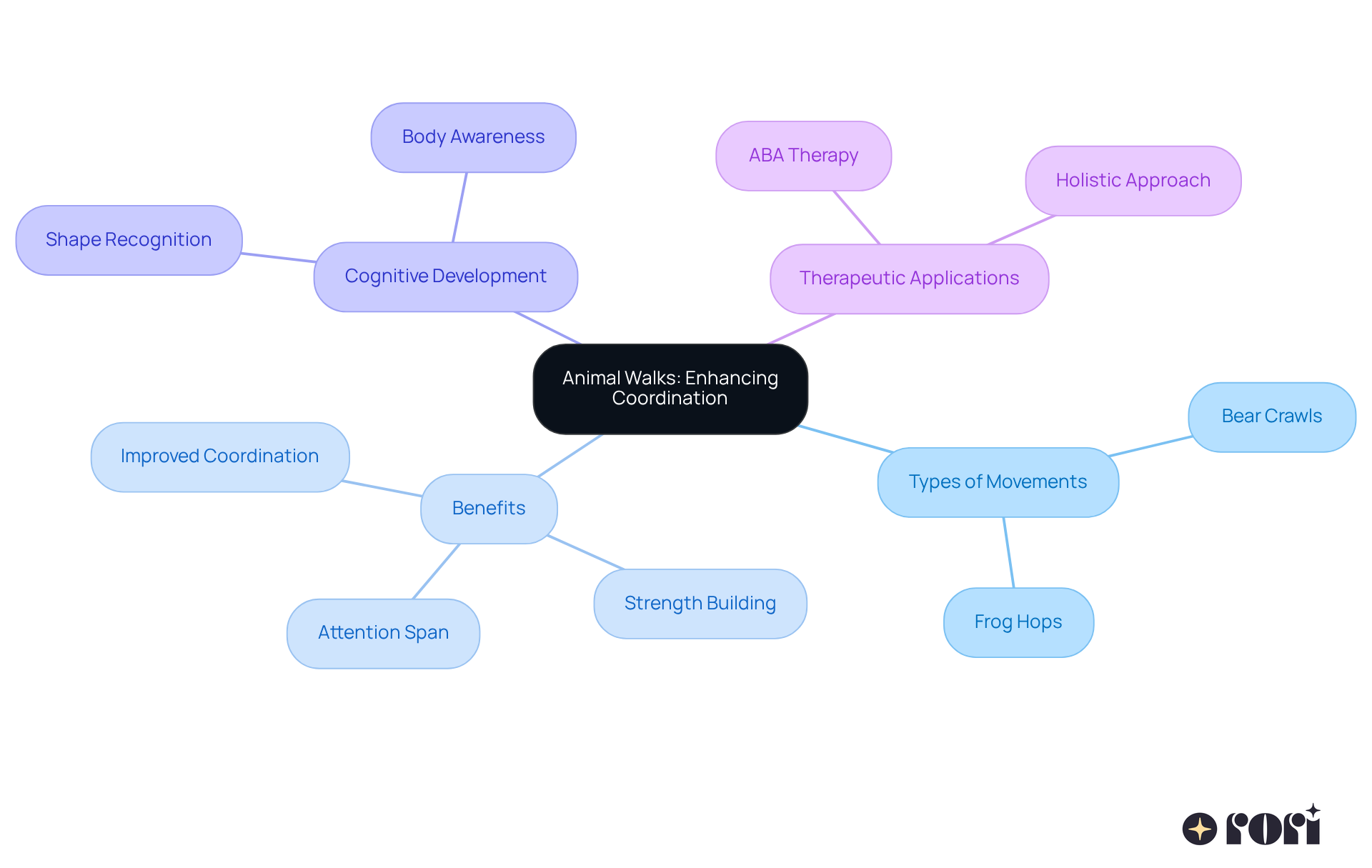
Obstacle courses are a fantastic way for kids to build essential gross motor actions aba, including skills like climbing, crawling, and balancing. At Rori Care, our caring clinical leadership team truly values neurodiversity and is dedicated to helping young people succeed. By designing a variety of fun challenges and applying evidence-based techniques, our therapists inspire kids to navigate the course, which greatly enhances their coordination, strength, and problem-solving abilities.
Did you know that kids who engage in organized physical activities, such as obstacle courses, often show remarkable improvements in focus and concentration? These skills are vital for their overall growth! Plus, we can customize these courses to fit each child’s unique skill level, making them a versatile and effective part of gross motor actions aba therapy.
Joining in on these activities not only boosts physical fitness but also fosters social interaction and teamwork. This, in turn, helps build a child’s confidence and self-worth. Our therapists often see how organized activities like obstacle courses play a crucial role in creating a fun learning environment. It motivates kids to thrive while also equipping caregivers with ABA principles and strategies to support their children’s behavioral goals. Let’s explore this together and see how we can make a difference in your child’s journey!
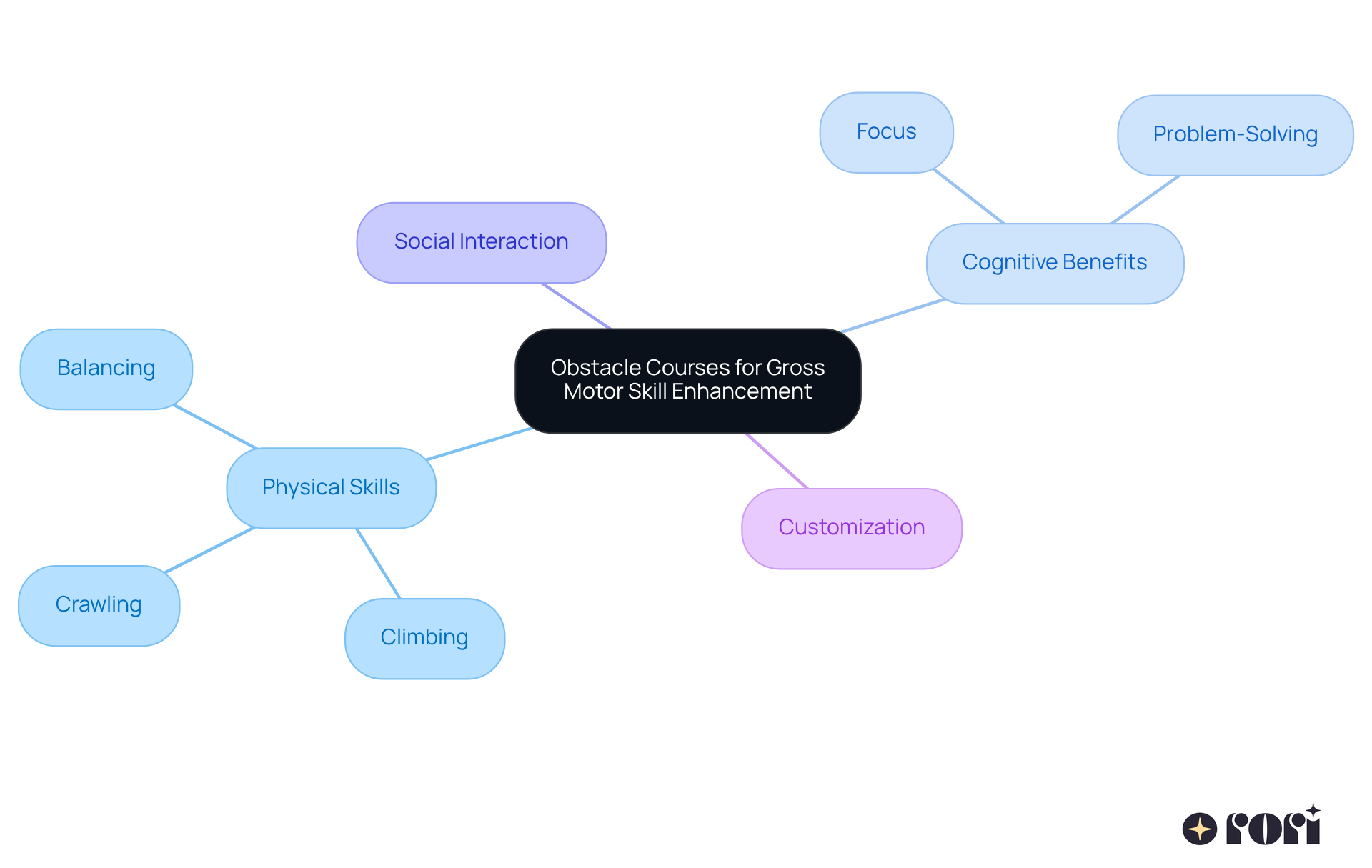
Dancing is such a lively and fun way for young individuals, especially those with autism, to improve their overall movement abilities! Engaging in rhythmic movements not only boosts coordination and balance but also enhances body awareness. Dance provides a unique platform for self-expression, allowing young people to creatively convey their emotions and ideas. This adaptability makes dance an inclusive activity, welcoming various skill levels and encouraging social interaction and emotional well-being.
At Rori Care, our clinical leadership team is all about fostering neurodiversity and supporting the success of young individuals through innovative therapeutic methods. Recent studies are shining a light on the healing possibilities of dance for youngsters on the autism spectrum. Dance therapy has shown significant improvements in coordination and social skills, helping kids interact better with their peers. Dance therapists emphasize that movement can be a powerful form of communication, enabling young individuals to express themselves in ways that words might not capture. The benefits of dance therapy go beyond just physical improvements; they also encompass emotional and social growth, making it a holistic approach for assisting youth with autism.
Looking ahead to 2025, the focus on dance as a therapeutic practice continues to grow, with studies highlighting its role in not only enhancing physical abilities but also fostering a sense of community and belonging among participants. By incorporating dance into therapeutic practices, young individuals can enjoy a joyful and engaging way to develop essential skills while building confidence and self-worth. Caregivers are encouraged to actively participate in their children's dance activities, reinforcing the principles of ABA therapy and supporting their behavioral goals through gross motor actions aba. Let’s explore this together!
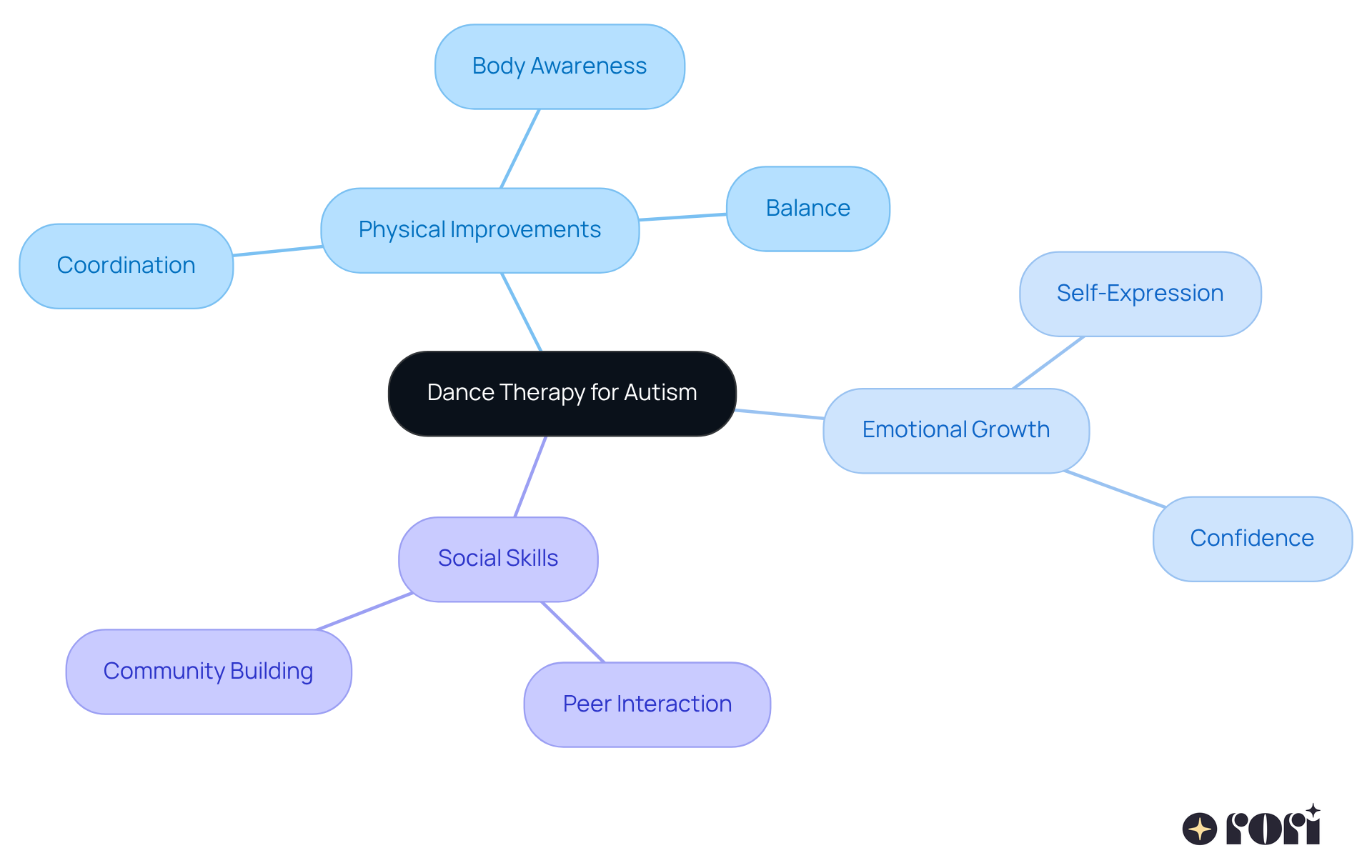
Yoga is a fantastic tool for helping individuals with autism improve their balance and coordination. When young people engage in different poses and breathing techniques, they not only build strength and flexibility but also gain a greater awareness of their bodies. Research shows that practicing yoga can lead to increased muscle strength, better tone, and improved balance—important factors for physical development.
But that’s not all! When yoga is combined with gross motor actions aba treatment, it becomes even more beneficial. It supports physical growth while also promoting emotional regulation and relaxation, creating a well-rounded therapeutic approach. Many parents have noticed that their children become more organized, experience fewer emotional outbursts, and have longer attention spans, which helps them transition between activities more smoothly.
Educators have found that yoga enhances coordination and emotional stability, thereby supporting gross motor actions aba in ABA therapy for individuals with autism. So, let’s explore this together! If you’re looking for ways to support your child’s development, yoga might just be the perfect addition to your routine.
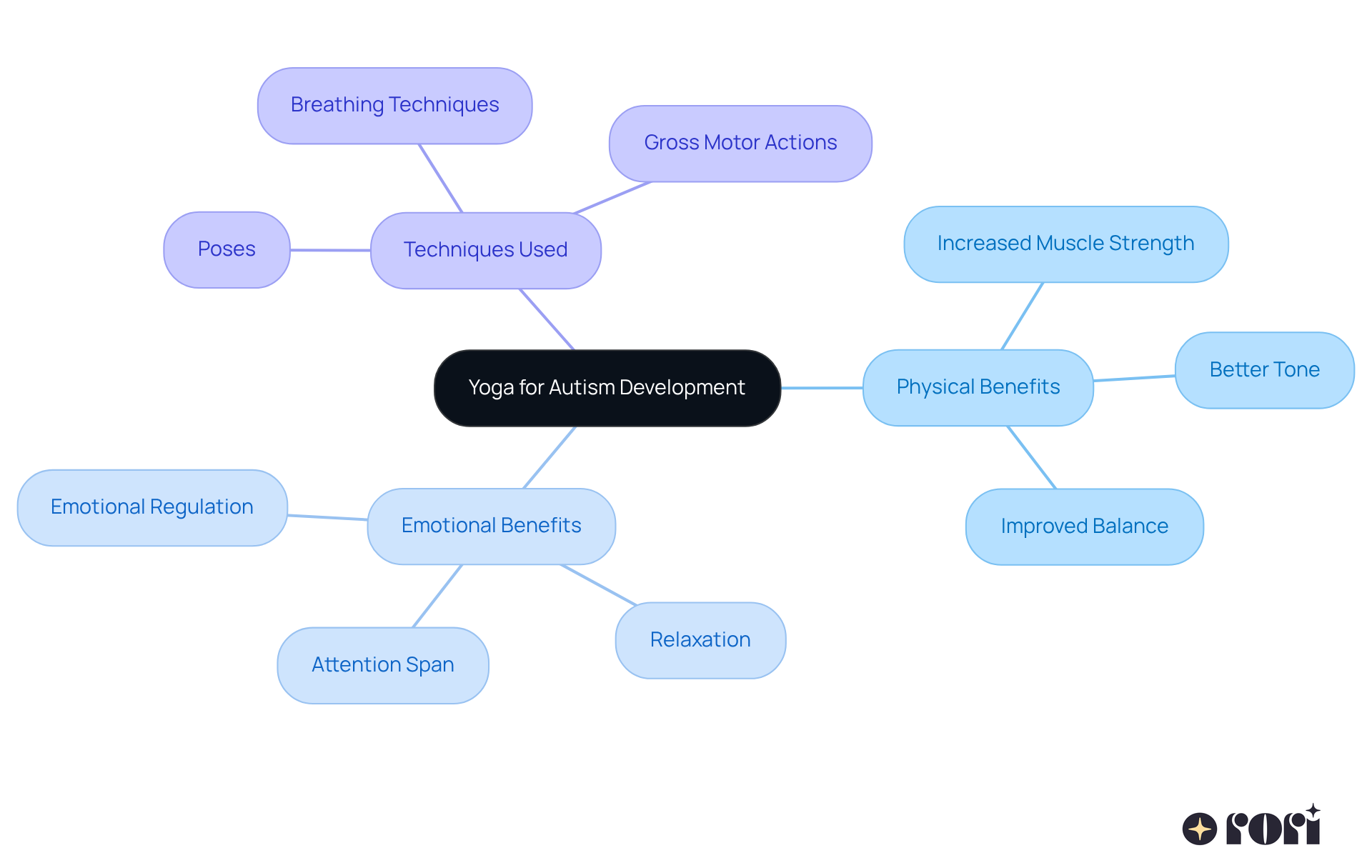
Participating in ball games like catch, kickball, or basketball can be a game-changer for children's gross motor development, especially for those with autism. These fun activities not only boost hand-eye coordination, balance, and timing but also nurture essential social skills like teamwork and communication. 🌟
Recent studies show that joining organized ball games can lead to noticeable improvements in movement skills and social interactions. For instance, kids involved in recreational ball games often show enhanced social cognition and communication abilities, which are crucial for their overall growth.
Plus, physical education experts emphasize that these games provide a fun and engaging way for kids to practice and refine their motor skills. They help build confidence and ease anxiety related to coordination. By weaving ball games into their routines, children can enjoy a holistic approach to development that promotes both physical fitness and social engagement. Let’s explore this together and see how we can support our little ones every step of the way!
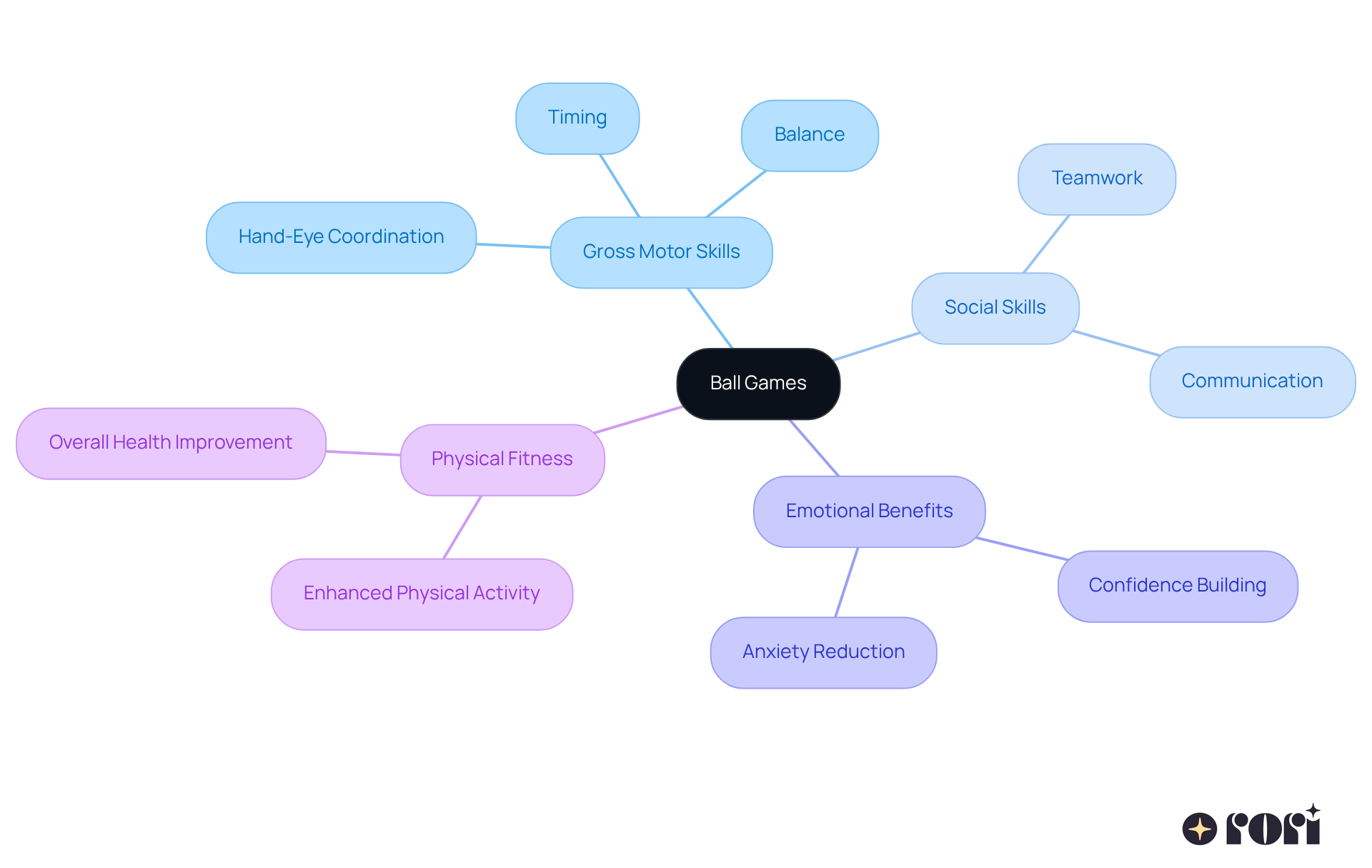
Jumping activities like trampoline bouncing and hopscotch are not just fun; they play a vital role in building strength and coordination in our little ones. These energetic exercises involve gross motor actions aba that engage large muscle groups, thereby boosting overall physical fitness. Did you know that trampoline treatment can be especially beneficial for autistic youth? It not only promotes physical growth but also adds joy to the learning journey!
Incorporating jumping into therapy sessions can work wonders for cardiovascular health and muscle tone, enhancing gross motor actions aba and making skill development both effective and enjoyable. Plus, outdoor activities like jumping help kids burn off energy and improve their fitness levels, contributing to their overall well-being. Fitness experts often rave about the transformative power of jumping, noting that it can lift moods and encourage active participation in therapy.
By incorporating gross motor actions aba into a regular routine of playful practices, therapists can create a more stimulating environment that nurtures youth development and mental well-being. Let’s explore this together! We’re here to help you every step of the way!
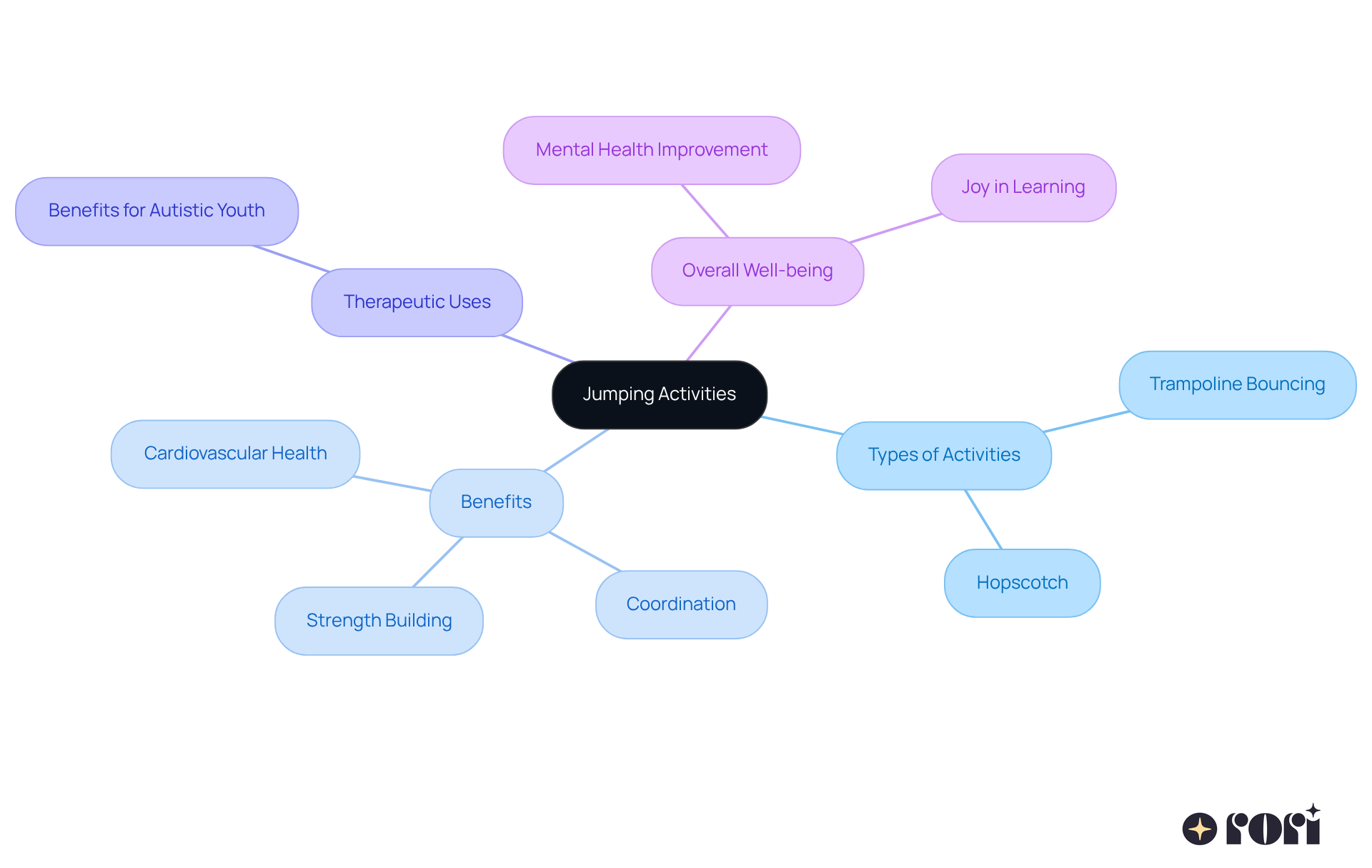
Climbing exercises, whether on playground structures or climbing surfaces, are fantastic ways to enhance large motor abilities in young individuals, especially those with autism. At Rori Care, our clinical leadership team is passionate about neurodiversity and children's success. We believe these activities are perfect for improving physical abilities since they require strength, balance, and coordination. Plus, engaging in climbing not only supports physical development but also gives a significant boost to confidence! 🌟 For example, rock wall climbing is a full-body workout that activates various muscle groups, including the shoulders, back, legs, and glutes, promoting overall strength and flexibility.
Research shows that climbing enhances both gross motor actions aba and fine motor skills, which are essential for daily activities. Children who participate in climbing activities often experience improvements in balance and coordination—skills that are foundational for academic readiness and success in school. Additionally, climbing encourages youngsters to assess their body position and make adjustments for better balance, promoting spatial awareness and problem-solving abilities.
Therapists have noticed that incorporating climbing into gross motor actions aba therapy can transform a young person's experience, making it not only therapeutic but also a lot of fun! The emotional resilience gained through climbing helps young individuals manage feelings of excitement and frustration, further enhancing their confidence. As they master climbing techniques, they develop a sense of achievement that extends into other areas of their lives, motivating them to tackle new challenges with enthusiasm.
Recent studies continue to highlight the benefits of climbing for children with autism, emphasizing its role in enhancing strength, coordination, and overall physical well-being. By weaving climbing into therapeutic methods, caregivers and clinicians at Rori Care can provide young individuals with engaging opportunities to develop crucial motor skills while fostering a sense of autonomy and self-efficacy. Let’s explore this together, and see how climbing can make a difference!
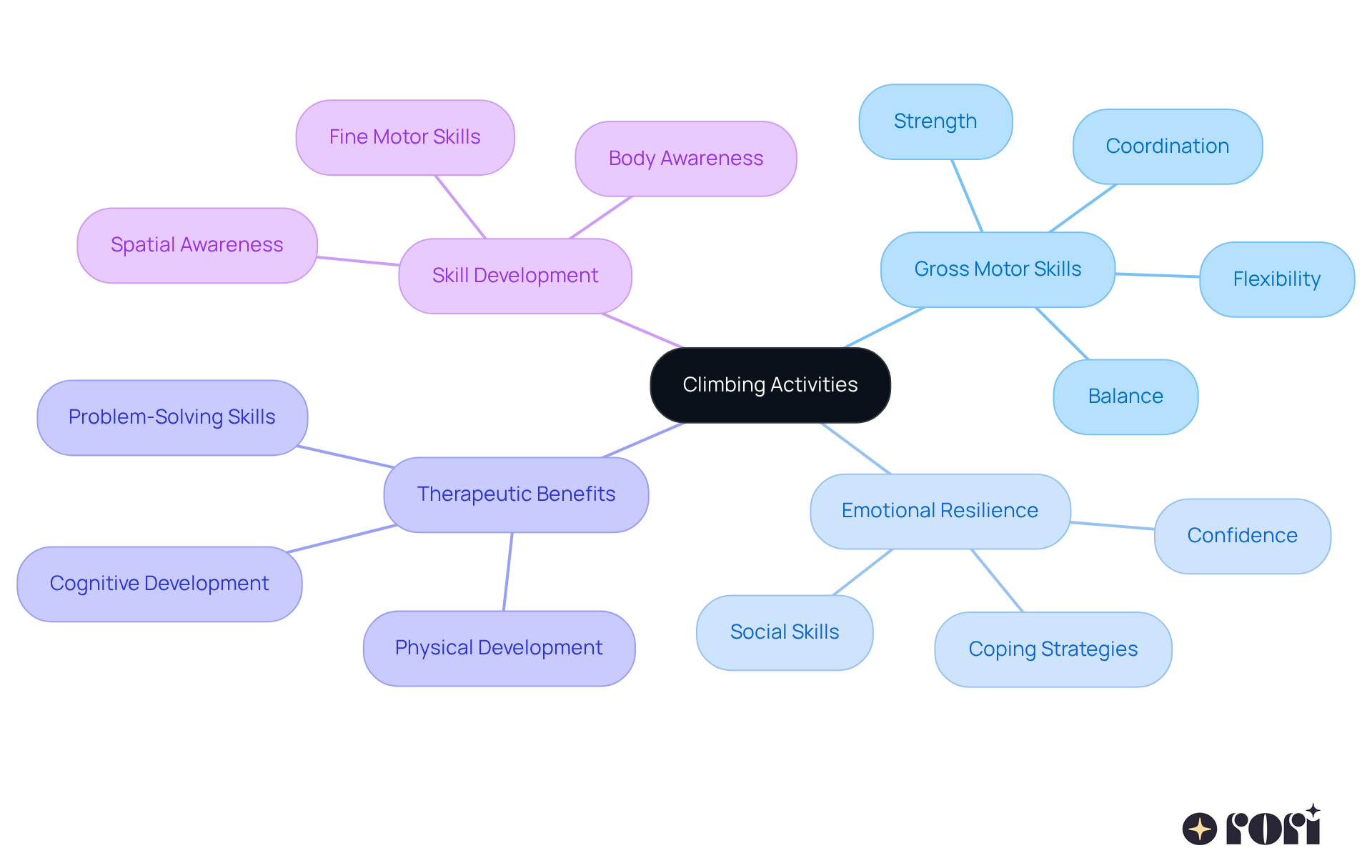
Riding a tricycle is a fantastic way for young ones to boost their coordination and develop gross motor actions aba! 🚴♂️ This fun activity gets various muscle groups moving, helping kids learn to pedal, steer, and navigate their surroundings—all while improving their balance. However, some children might find tricycle riding a bit tricky due to balance or coordination challenges. You might notice signs like hesitance to hop on the tricycle, fear of moving, or confusion about how to move their legs.
Incorporating tricycle riding into treatment sessions can make physical development not just effective but enjoyable, too! It provides a structured approach to tackling these motor skills. For many children with autism, mastering tricycle riding can truly enhance their physical abilities, leading to greater independence and confidence in their movements. As they practice, they’re not just learning to ride; they’re developing essential skills that will benefit them in other areas of life. This makes tricycle riding an important component of gross motor actions aba therapy!
Research shows that regularly engaging in activities like tricycle riding can lead to real improvements in balance and coordination. So, why not create a safe space for your child to practice? Encourage them with positive reinforcement as they learn to ride. By empowering our little ones with these skills, Rori Care helps them navigate the world more independently, reinforcing how effective ABA therapy can be in fostering meaningful growth. Let’s explore this journey together!

Swimming is such a fantastic exercise for boosting gross motor actions aba! It engages the whole body in a gentle, low-impact way. The water’s resistance offers a unique challenge that really helps improve strength, coordination, and balance.
Recent studies show that swimming enhances overall gross motor actions aba and also supports sensory regulation. This is especially beneficial for kids with autism in improving their gross motor actions aba. Instructors often highlight how the calming effects of water provide deep pressure and gentle resistance, which can help manage sensory input, ease anxiety, and promote relaxation.
One interesting study found that kids who swam scored significantly better in all areas of the Movement Assessment Battery for Children (MABC-2) compared to those who didn’t swim. This really underscores how swimming can positively impact motor abilities! Plus, participating in organized water activities allows young people to build strength and develop gross motor actions aba in a supportive environment, leading to greater independence and confidence.
And let’s not forget about water safety! Teaching essential skills is crucial for children with autism, as they face a higher risk of water-related incidents. So, let’s explore this together and ensure our little ones are both safe and thriving in the water!
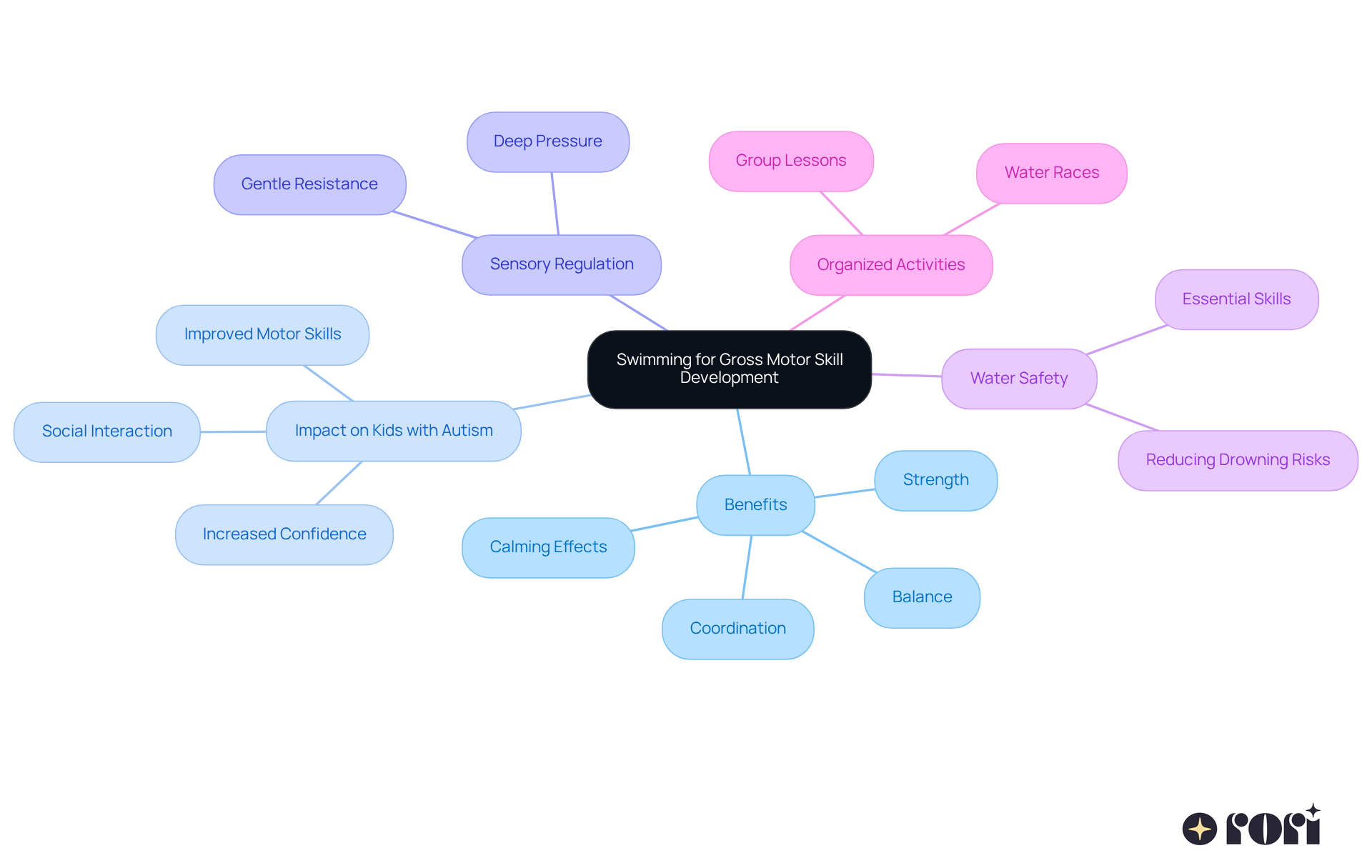
At Rori Care, we truly understand how vital it is to use tailored ABA therapy techniques to boost gross motor skills in children with autism. By creating individualized treatment plans and incorporating engaging activities, our therapy not only enhances physical abilities but also nurtures confidence and independence in these young individuals. Imagine the joy of seeing your child thrive through fun exercises like animal walks, obstacle courses, and dance! These activities create an enriching environment that supports both physical and cognitive development.
Throughout our journey, we’ve highlighted key techniques like:
Each of these activities is designed to target specific motor skills while also encouraging social interaction and emotional growth. It’s amazing to see how the synergy between physical movement and therapeutic practices allows children to flourish in a supportive setting, reinforcing their learning and development.
Ultimately, enhancing gross motor skills in children with autism is a collaborative effort involving therapists, caregivers, and the children themselves. By embracing these engaging activities and consistently applying ABA principles, you as caregivers can play a vital role in your child’s progress. The significance of these techniques truly cannot be overstated; they pave the way for greater independence and a brighter future for children with autism. Let’s explore this together and continue implementing these strategies, ensuring that every child has the opportunity to flourish and succeed!
What is Rori Care's approach to ABA therapy for children with autism?
Rori Care uses a data-driven approach to ABA therapy, focusing on individualized treatment plans that cater to each child's specific gross motor skill needs. Clinicians conduct thorough evaluations to identify each child's unique strengths and challenges, allowing for targeted interventions that foster skill development.
How does Rori Care utilize technology in their therapy sessions?
Rori Care employs advanced AI technology to streamline the creation of progress reports and data gathering during therapy sessions. This increases efficiency and frees up 50% more time for direct treatment, enhancing the overall effectiveness of the therapy.
What additional support does Rori Care provide to caregivers?
Rori Care equips caregivers with practical strategies, including the application of ABA principles at home and participation in data collection, to support their children’s behavioral goals.
What are animal walks and how do they benefit children?
Animal walks, such as bear crawls and frog hops, are engaging gross motor activities that improve coordination and strength in children. These playful exercises engage multiple muscle groups and enhance body awareness, coordination, and cognitive abilities.
How do animal movements contribute to ABA therapy?
Integrating animal movements into therapy sessions can enhance physical fitness, attention spans, and overall coordination, making them a valuable part of ABA therapy for individuals with autism.
What role do obstacle courses play in gross motor skill development?
Obstacle courses help children develop essential gross motor skills like climbing, crawling, and balancing. They enhance coordination, strength, and problem-solving abilities while also improving focus and concentration.
Can obstacle courses be customized for individual children?
Yes, Rori Care customizes obstacle courses to fit each child’s unique skill level, making them a versatile and effective component of gross motor skill development in ABA therapy.
What social benefits do organized activities like obstacle courses provide?
Organized activities, such as obstacle courses, promote social interaction and teamwork, helping to build a child’s confidence and self-worth while creating a fun learning environment.